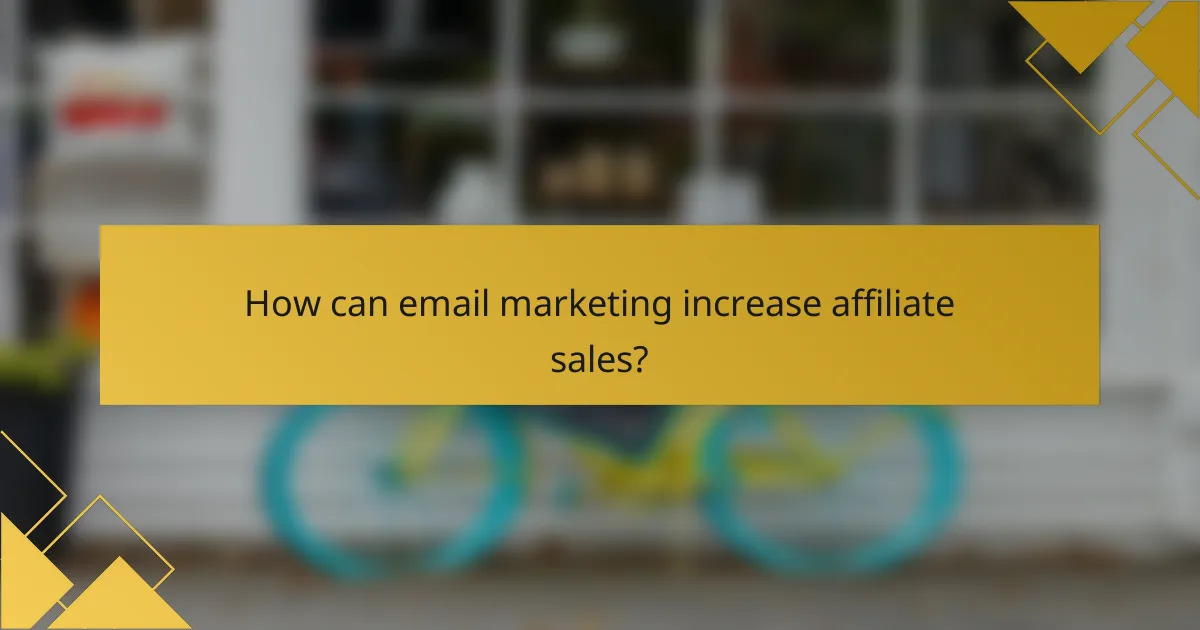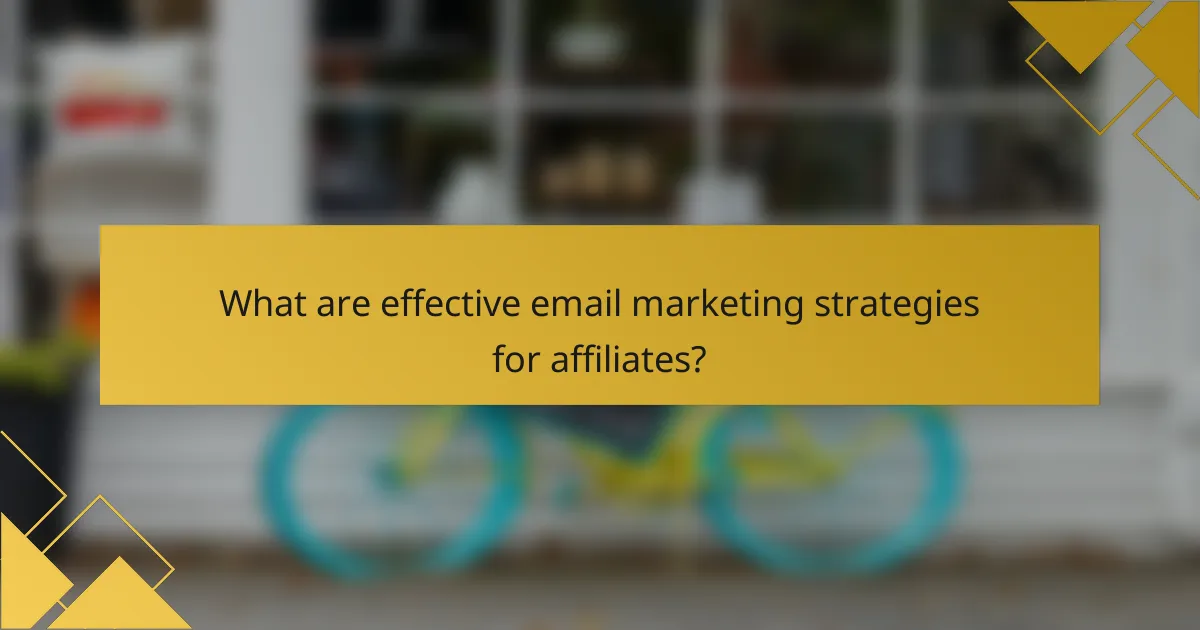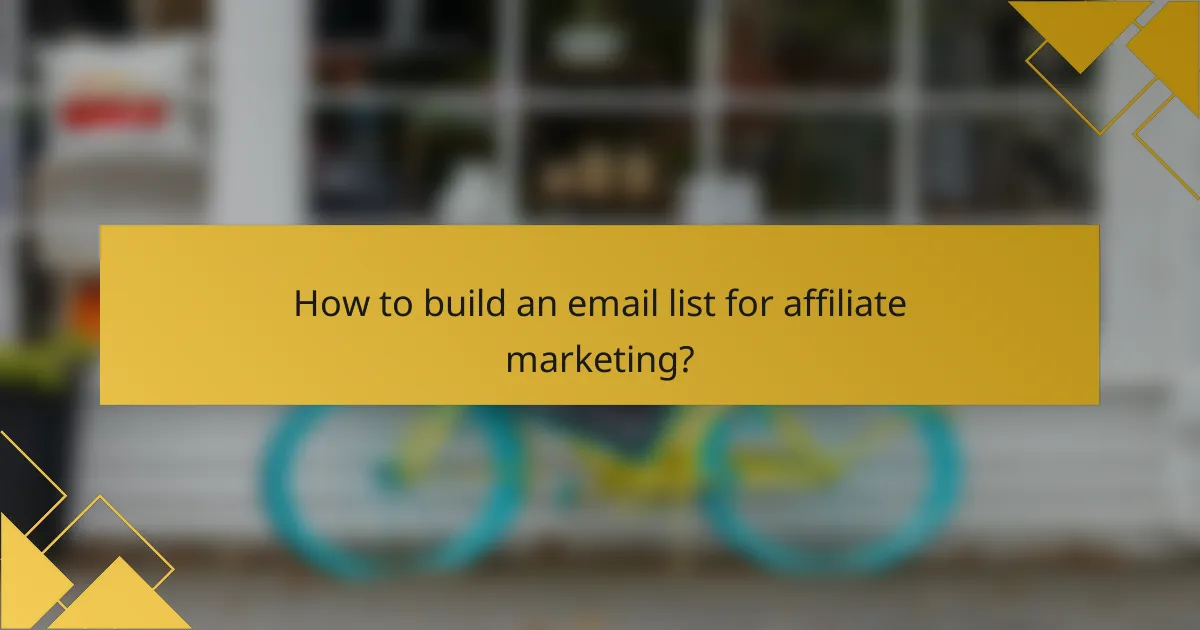Email marketing is a powerful tool for boosting affiliate sales, as it allows marketers to engage directly with potential customers and guide them through the purchasing journey. By implementing targeted campaigns, personalized content, and automation, affiliates can significantly improve conversion rates and increase sales through their affiliate links.

How can email marketing increase affiliate sales?
Email marketing can significantly boost affiliate sales by directly engaging potential customers and guiding them through the buying process. By leveraging targeted campaigns, personalized content, and automation, marketers can enhance conversion rates and drive more sales through affiliate links.
Targeted email campaigns
Targeted email campaigns focus on specific audience segments to deliver relevant content that resonates with their interests. By analyzing customer behavior and preferences, marketers can create tailored messages that encourage recipients to click on affiliate links. For instance, sending product recommendations based on previous purchases can lead to higher engagement and sales.
To implement targeted campaigns effectively, consider using tools that allow for audience segmentation based on demographics, purchase history, or engagement levels. This ensures that your emails are not only opened but also acted upon, maximizing the potential for affiliate sales.
Personalized content strategies
Personalized content strategies involve customizing email content to meet the unique needs and preferences of individual recipients. This can include using the recipient’s name, recommending products based on past interactions, or providing exclusive offers tailored to their interests. Personalization can increase open rates and drive more clicks on affiliate links.
Utilize data from previous campaigns to refine your approach. For example, if a subscriber frequently clicks on fitness-related products, prioritize similar offers in future emails. This targeted personalization can significantly enhance the likelihood of conversion.
Automated follow-up sequences
Automated follow-up sequences are essential for nurturing leads and encouraging conversions over time. After a subscriber engages with your initial email, setting up a series of automated emails can keep your affiliate products top-of-mind. These sequences can include reminders, additional product recommendations, or exclusive discounts to entice purchases.
To create effective follow-up sequences, map out the customer journey and identify key touchpoints. For instance, if a subscriber clicks on a product link but doesn’t purchase, a follow-up email offering a limited-time discount can prompt them to complete the sale.
Segmentation for higher engagement
Segmentation involves dividing your email list into smaller groups based on shared characteristics or behaviors. This strategy allows for more relevant messaging, which can lead to higher engagement rates and increased affiliate sales. For example, segmenting by purchase behavior can help you target customers who are more likely to respond to specific offers.
Consider using segmentation criteria such as location, purchase frequency, or engagement history. By tailoring your emails to these segments, you can improve open rates and click-through rates, ultimately driving more traffic to your affiliate links and boosting sales.

What are effective email marketing strategies for affiliates?
Effective email marketing strategies for affiliates focus on engaging the audience and driving conversions. By employing techniques like A/B testing, crafting compelling subject lines, and incorporating strong calls to action (CTAs), affiliates can significantly enhance their email campaigns and boost sales.
Utilizing A/B testing
A/B testing involves sending two variations of an email to different segments of your audience to determine which performs better. This method allows affiliates to test elements such as subject lines, content layout, and CTAs to optimize engagement and conversion rates.
When conducting A/B tests, ensure you only change one element at a time to accurately measure its impact. Aim for a sample size that provides statistically significant results, typically in the low hundreds to thousands, depending on your overall email list size.
Crafting compelling subject lines
Compelling subject lines are crucial for increasing open rates. They should be concise, intriguing, and relevant to the content of the email. Using personalization, such as including the recipient’s name, can also enhance effectiveness.
Consider using action-oriented language and creating a sense of urgency or exclusivity. For example, phrases like “Limited Time Offer” or “Exclusive Access” can encourage recipients to open the email promptly.
Incorporating strong CTAs
Strong calls to action (CTAs) guide recipients on what to do next, making them essential for driving conversions. Ensure your CTAs are clear, visually distinct, and placed prominently within the email.
Use actionable language, such as “Shop Now” or “Get Your Discount,” and consider testing different placements and designs. A/B testing CTAs can reveal which versions resonate best with your audience, leading to higher click-through rates.

How to build an email list for affiliate marketing?
Building an email list for affiliate marketing involves attracting potential customers who are interested in your niche. This list serves as a direct line of communication to promote products and drive sales through targeted campaigns.
Lead magnets for list growth
Lead magnets are valuable resources offered to entice users to subscribe to your email list. Examples include eBooks, exclusive discounts, webinars, or free trials. The key is to ensure that the lead magnet is relevant and appealing to your target audience.
To maximize effectiveness, consider using a combination of lead magnets tailored to different segments of your audience. For instance, a fitness blog might offer a free workout plan for beginners while also providing advanced training guides for seasoned athletes.
Landing page optimization
Optimizing your landing page is crucial for converting visitors into subscribers. Ensure that your landing page has a clear and compelling call-to-action (CTA) that highlights the benefits of subscribing. Use concise, persuasive copy and visually appealing design elements to capture attention.
Additionally, A/B testing different elements such as headlines, images, and CTAs can help identify what resonates best with your audience. Aim for a clean layout that minimizes distractions and focuses on the subscription form.
Social media integration
Integrating social media into your email list-building strategy can significantly enhance your reach. Promote your lead magnets and landing pages across your social media platforms to drive traffic and encourage sign-ups. Utilize engaging posts, stories, and ads to capture interest.
Consider running contests or giveaways on social media that require participants to subscribe to your email list. This not only boosts your list but also increases engagement with your brand across multiple channels.

What metrics should affiliates track in email marketing?
Affiliates should track key metrics such as open rates, click-through rates, and conversion rates to evaluate the effectiveness of their email marketing campaigns. Monitoring these metrics helps identify areas for improvement and optimize strategies for better sales performance.
Open rates analysis
Open rates indicate the percentage of recipients who opened an email compared to the total number of emails sent. A good open rate typically falls between 15% and 25%, depending on the industry. To improve open rates, consider optimizing subject lines and sending times.
Testing different subject lines through A/B testing can provide insights into what resonates with your audience. Additionally, segmenting your email list can help tailor messages to specific groups, potentially increasing engagement.
Click-through rates
Click-through rates (CTR) measure the percentage of email recipients who clicked on one or more links within the email. A healthy CTR usually ranges from 2% to 5%, but this can vary widely based on the niche. To enhance CTR, ensure that your calls-to-action (CTAs) are clear and compelling.
Using engaging visuals and concise text can also encourage clicks. Regularly analyze which links receive the most clicks to refine your content strategy and focus on what your audience finds appealing.
Conversion tracking
Conversion tracking involves monitoring the percentage of email recipients who complete a desired action, such as making a purchase or signing up for a service. This metric is crucial for assessing the overall effectiveness of your email campaigns. Aim for a conversion rate of around 1% to 3% for affiliate marketing efforts.
To effectively track conversions, set up proper tracking links and use analytics tools to measure performance. Be mindful of the customer journey; optimizing landing pages and ensuring a seamless experience can significantly boost conversion rates.

How to avoid common email marketing pitfalls?
To avoid common email marketing pitfalls, focus on compliance, deliverability, and user experience. Implementing best practices in these areas can significantly enhance your affiliate sales efforts.
Maintaining compliance with regulations
Adhering to email marketing regulations, such as the CAN-SPAM Act in the United States or GDPR in Europe, is crucial. These laws require clear consent from recipients and provide guidelines on how to manage their data.
Ensure that your emails include an easy opt-out option and that you respect unsubscribe requests promptly. Failing to comply can lead to hefty fines and damage your brand’s reputation.
Avoiding spam filters
To prevent your emails from landing in spam folders, focus on building a clean email list. Use double opt-in methods to confirm subscriptions and regularly clean your list to remove inactive users.
Craft clear subject lines and avoid spammy words like “free” or “guaranteed.” Additionally, maintain a good sender reputation by monitoring your bounce rates and engagement metrics.
Ensuring mobile optimization
With a significant portion of emails opened on mobile devices, optimizing your emails for mobile is essential. Use responsive design to ensure that your content displays well on various screen sizes.
Keep your email layout simple, with concise text and clear calls to action. Test your emails on multiple devices before sending to ensure a seamless experience for all users.

What tools can enhance email marketing efforts?
Several tools can significantly improve your email marketing efforts, leading to increased affiliate sales. These tools help streamline campaign management, optimize content, and analyze performance, ensuring your strategies are effective and data-driven.
Email Service Providers (ESPs)
Email Service Providers are essential for managing your email campaigns. They allow you to create, send, and track emails efficiently. Popular ESPs like Mailchimp, Constant Contact, and Sendinblue offer user-friendly interfaces and automation features that can save you time and enhance engagement.
When choosing an ESP, consider factors such as pricing, ease of use, and available integrations. Many providers offer tiered pricing based on the number of subscribers, making it easier to find a solution that fits your budget.
Analytics Tools
Analytics tools are crucial for measuring the success of your email marketing campaigns. They provide insights into open rates, click-through rates, and conversion rates, helping you understand what resonates with your audience. Google Analytics can be integrated with your email campaigns to track user behavior after they click through from your emails.
Utilizing analytics allows you to refine your strategies based on real data. Focus on key performance indicators (KPIs) to assess the effectiveness of your campaigns and make informed adjustments.
Design Tools
Design tools help create visually appealing emails that capture attention and drive engagement. Platforms like Canva and Adobe Spark offer templates and design elements that can enhance your email aesthetics without requiring advanced design skills.
When designing your emails, ensure they are mobile-friendly, as a significant portion of users access emails on their smartphones. A responsive design can improve user experience and increase click-through rates.
Automation Software
Automation software allows you to send targeted emails based on user behavior, which can significantly boost your affiliate sales. Tools like HubSpot and ActiveCampaign enable you to set up automated workflows that trigger emails based on specific actions, such as cart abandonment or new sign-ups.
Implementing automation can save time and ensure timely communication with your audience. However, be cautious not to over-automate, as personalized touches can enhance engagement and build stronger relationships with your subscribers.









